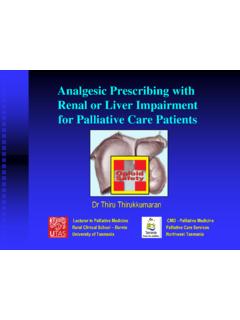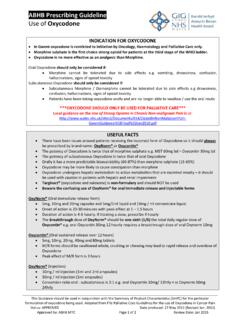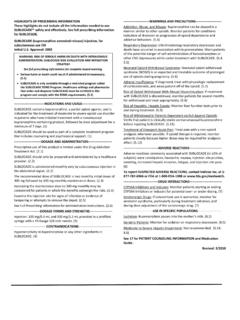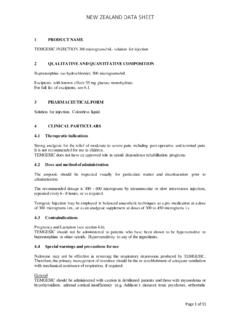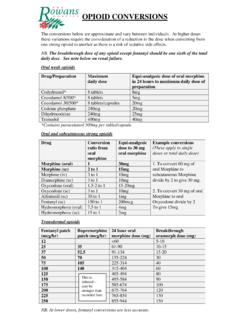Transcription of ACTIQ Patients must require and use around -the clock ...
1 HIGHLIGHTS OF prescribing INFORMATION These highlights do not include all the information needed to use ACTIQ safely and effectively. See full prescribing information for ACTIQ . ACTIQ (fentanyl citrate) oral transmucosal lozenge, CII Initial Approval: 1968 WARNING: LIFE-THREATENING RESPIRATORY DEPRESSION; ACCIDENTAL INGESTION; RISKS FROM CYTOCHROME P450 3A4 INTERACTION; RISKS FROM CONCOMITANT USE WITH BENZODIAZEPINES OR OTHER CNS DEPRESSANTS; RISK OF MEDICATION ERRORS; ADDICTION, ABUSE, AND MISUSE; REMS; and NEONATAL OPIOID WITHDRAWAL SYNDROME See full prescribing information for complete boxed warning. Serious, life-threatening, and/or fatal respiratory depression has occurred. Monitor closely, especially upon initiation or following a dose increase. Due to the risk of fatal respiratory depression, ACTIQ is contraindicated in opioid non-tolerant Patients (1) and in management of acute or postoperative pain, including headache/migraines.
2 (5. 1) Accidental ingestion of ACTIQ , especially by children, can result in a fatal overdose of fentanyl. Keep out of reach of children. Ensure proper storage and disposal. ( , ) Concomitant use with CYP3A4 inhibitors (or discontinuation of CYP3A4 inducers) can result in a fatal overdose of fentanyl. ( , 7, ) Concomitant use of opioids with benzodiazepines or other central nervous system (CNS) depressants, including alcohol, may result in profound sedation, respiratory depression, coma, and death. Reserve concomitant prescribing for use in Patients for whom alternative treatment options are inadequate; limit dosages and durations to the minimum required; and follow Patients for signs and symptoms of respiratory depression and sedation. ( , 7) When prescribing , do not convert Patients on a mcg per mcg basis from any other fentanyl product to ACTIQ .
3 ( ) When dispensing, do not substitute with any other fentanyl products. ( ) ACTIQ exposes users to risks of addiction, abuse, and misuse, which can lead to overdose and death. Assess patient s risk before prescribing and monitor closely for these behaviors and conditions. ( ) ACTIQ is available only through a restricted program called the TIRF REMS Access program. Outpatients, healthcare professionals who prescribe to outpatients, pharmacies, and distributors are required to enroll in the program. ( ) Prolonged use of ACTIQ during pregnancy can result in neonatal opioid withdrawal syndrome, which may be life-threatening if not recognized and treated. If prolonged opioid use is required in a pregnant woman, advise the patient of the risk of neonatal opioid withdrawal syndrome and ensure that appropriate treatment will be available. ( ) ----------------------------RECENT MAJOR CHANGES------------------------- Boxed Warning 12 /2016 Dosage and Administration ( ) 12 /2016 Contraindications (4) 12 /2016 Warnings and Precautions (5) 12 /2016 ----------------------------INDICATIONS AND USAGE--------------------------- ACTIQ is an opioid agonist indicated for the management of breakthrough pain in cancer Patients 16 years of age and older who are already receiving and who are tolerant to around -the- clock opioid therapy for their underlying persistent cancer pain.
4 Patients considered opioid tolerant are those who are taking, for one week or longer, around -the- clock medicine consisting of at least 60 mg of oral morphine per day, at least 25 mcg of transdermal fentanyl per hour, at least 30 mg of oral oxycodone per day, at least 8 mg of oral hydromorphone per day, at least 25 mg oral oxymorphone per day, at least 60 mg oral hydrocodone per day, or an equianalgesic dose of another opioid daily for a week or longer. Patients must remain on around -the- clock opioids while taking ACTIQ . Limitations of Use Not for use in opioid non-tolerant Patients . Not for use in the management of acute or postoperative pain, including headache/migraine or dental pain. (4) As a part of the TIRF REMS Access program, ACTIQ may be dispensed only to outpatients enrolled in the program. ( ) For inpatient administration of ACTIQ ( , hospitals, hospices, and long-term care facilities that prescribe for inpatient use), patient and prescriber enrollment is not required.
5 ----------------------DOSAGE AND ADMINISTRATION----------------------- Patients must require and use around -the - clock opioids when taking ACTIQ . (1) Use the lowest effective dosage for the shortest duration consistent with individual patient treatment goals. ( ) Individualize dosing based on the severity of pain, patient response, prior analgesic experience, and risk factors for addiction, abuse, and misuse. ( ) Initial dose of ACTIQ : 200 mcg. Prescribe an initial supply of six 200 mcg ACTIQ units. ( ) Individually titrate to a tolerable dose that provides adequate analgesia using single ACTIQ dosage unit per breakthrough cancer pain episode. ( ) No more than two doses can be taken per breakthrough pain episode. (2. 3, ) Wait at least 4 hours before treating another episode of breakthrough pain with ACTIQ . ( , ) Limit consumption to four or fewer units per day once successful dose is found.
6 ( ) When opioid therapy is no longer required, consider discontinuing ACTIQ along with a gradual downward of other opioids to minimize possible withdrawal effects. ( ) ---------------------DOSAGE FORMS AND STRENGTHS---------------------- Solid oral transmucosal lozenge: 200 mcg, 400 mcg, 600 mcg, 800 mcg, 1200 mcg, and 1600 mcg. (3) -------------------------------CONTRAIND ICATIONS------------------------------ Opioid non-tolerant Patients . (4) Significant respiratory depression. (4) Management of acute or postoperative pain including headache/migraines and dental pain. (4) Acute or severe bronchial asthma in an unmonitored setting or in absence of resuscitative equipment. (4) Known or suspected gastrointestinal obstruction, including paralytic ileus. (4) Known hypersensitivity to fentanyl or components of ACTIQ . (4) -----------------------WARNINGS AND PRECAUTIONS---------------------- Life-Threatening Respiratory Depression in Patients with Chronic Pulmonary Disease or in Elderly, Cachectic, or Debilitated Patients : Monitor closely, particularly during initiation and titration.
7 ( ) Serotonin Syndrome: Potentially life-threatening condition could result from concomitant serotonergic drug administration. Discontinue ACTIQ if serotonin syndrome is suspected. ( ) Adrenal Insufficiency: If diagnosed, treat with physiologic replacement of corticosteroids, and wean patient off of the opioid. ( ) Severe Hypotension: Monitor during dosage initiation and titration. Avoid use of ACTIQ in Patients with circulatory shock. ( ) Risks of Use in Patients with Increased Intracranial Pressure, Brain Tumors, Head Injury, or Impaired Consciousness: Monitor for sedation and respiratory depression. Avoid use of ACTIQ in Patients with impaired consciousness or coma. ( ) ------------------------------ADVERSE REACTIONS------------------------------- Most common (frequency 5%): nausea, dizziness, somnolence, vomiting, asthenia, and headache, dyspnea, constipation, anxiety, confusion, depression, rash, and insomnia.
8 ( ) To report SUSPECTED ADVERSE REACTIONS, contact Teva Pharmaceuticals at 1-888-483-8279 or FDA at 1-800-FDA-1088 or ------------------------------DRUG INTERACTIONS---------------------------- --- Mixed Agonist/Antagonist and Partial Agonist Opioid Analgesics: Avoid the use of mixed agonist/antagonist or partial agonist analgesics in Patients who are already receiving a full opioid agonist analgesic (including ACTIQ ) because they may reduce analgesic effect of ACTIQ or precipitate withdrawal symptoms. (7) -----------------------USE IN SPECIFIC POPULATIONS------------------------ Pregnancy: May cause fetal harm. ( ) Lactation: Not recommended. Renal and Hepatic Impairment: Administer ACTIQ with caution. ( ) See 17 for PATIENT COUNSELING INFORMATION and Medication Guide. Revised: 12 /2016 _____ FULL prescribing INFORMATION: CONTENTS* WARNING: LIFE-THREATENING RESPIRATORY DEPRESSION; ACCIDENTAL INGESTION; RISKS FROM CYTOCHROME P450 3A4 INTERACTION; RISKS FROM CONCOMITANT USE WITH BENZODIAZEPINES OR OTHER CNS DEPRESSANTS; RISK OF MEDICATION ERRORS; ADDICTION, ABUSE, AND MISUSE; REMS.
9 And NEONATAL OPIOID WITHDRAWAL SYNDROME 1 INDICATIONS AND USAGE 2 DOSAGE AND ADMINISTRATION Important Dosage and Administration Instructions Initial Dosage Dose Titration Maintenance Dosing Administration of ACTIQ Discontinuation of ACTIQ Disposal of ACTIQ 3 DOSAGE FORMS AND STRENGTHS 4 CONTRAINDICATIONS 5 WARNINGS AND PRECAUTIONS Life-Threatening Respiratory Depression Increased Risk of Overdose in Children Due to Accidental Ingestion or Exposure Risks of Concomitant Use or Discontinuation of Cytochrome P450 3A4 Inhibitors and Inducers Risks from Concomitant Use with Benzodiazepines or Other CNS Depressants (including Alcohol) Risk of Medication Errors Addiction, Abuse, and Misuse Transmucosal Immediate Release Fentanyl (TIRF) Risk Evaluation and Mitigation Strategy (REMS) Access Program Neonatal Opioid Withdrawal Syndrome Life-Threatening Respiratory Depression in Patients with Chronic Pulmonary Disease or in Elderly, Cachectic, or Debilitated Patients Serotonin Syndrome with Concomitant Use of Serotonergic Drugs Adrenal Insufficiency Severe Hypotension Risks of Use in Patients with Increased Intracranial Pressure, Brain Tumors, Head Injury.
10 Or Impaired Consciousness Risks of Use in Patients with Gastrointestinal Conditions Increased Risk of Seizures in Patients with Seizure Disorders Risks of Driving and Operating Machinery Cardiac Disease MAO Inhibitors 6 ADVERSE REACTIONS Clinical Studies Experience Postmarketing Experience 7 DRUG INTERACTIONS 8 USE IN SPECIFIC POPULATIONS Pregnancy Lactation Females and Males of Reproductive Potential Pediatric Use Geriatric Use Patients with Renal or Hepatic Impairment Sex 9 DRUG ABUSE AND DEPENDENCE Controlled Substance Abuse Dependence 10 OVERDOSAGE 11 DESCRIPTION 12 CLINICAL PHARMACOLOGY Mechanism of Action Pharmacodynamics Pharmacokinetics 13 NONCLINICAL TOXICOLOGY Carcinogenesis, Mutagenesis, Impairment of Fertility 14 CLINICAL STUDIES 16 HOW SUPPLIED/STORAGE AND HANDLING 17 PATIENT COUNSELING INFORMATION * Sections or subsections omitted from the full prescribing information are not FULL prescribing INFORMATION WARNING: LIFE-THREATENING RESPIRATORY DEPRESSION; ACCIDENTAL INGESTION; RISKS FROM CYTOCHROME P450 3A4 INTERACTION; RISKS FROM CONCOMITANT USE WITH BENZODIAZEPINES OR OTHER CNS DEPRESSANTS; RISK OF MEDICATION ERRORS; ADDICTION, ABUSE, AND MISUSE; REMS; and NEONATAL OPIOID WITHDRAWAL SYNDROME Life-Threatening Respiratory Depression Serious, life-threatening and/or fatal respiratory depression has occurred in Patients treated with ACTIQ , including following use in opioid non-tolerant Patients and improper dosing.
